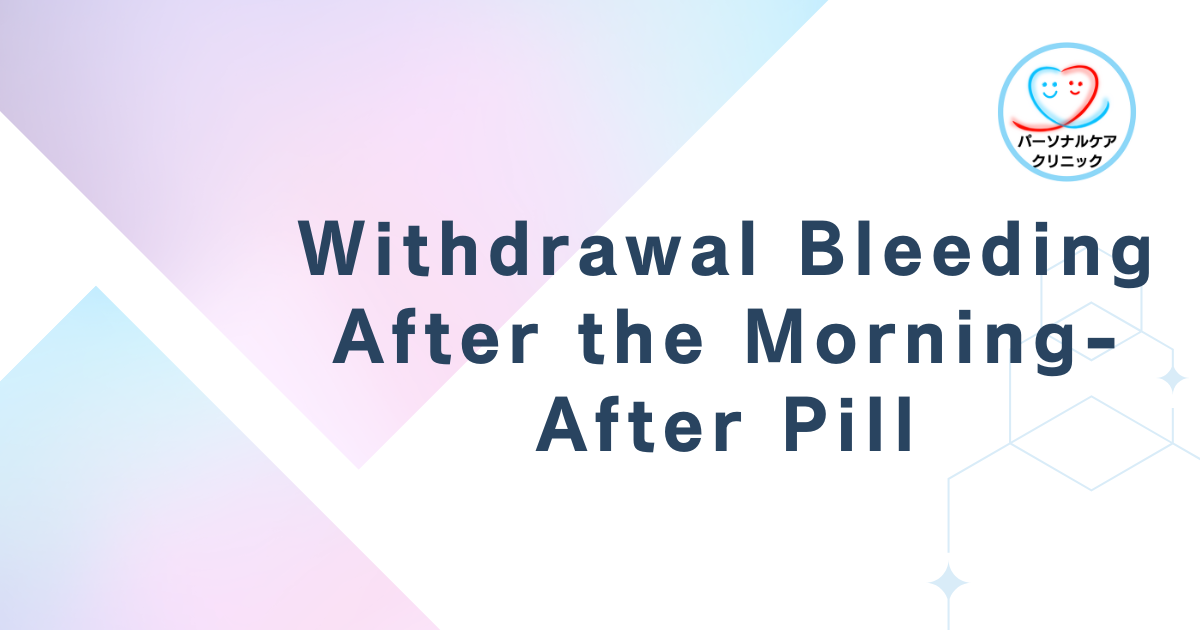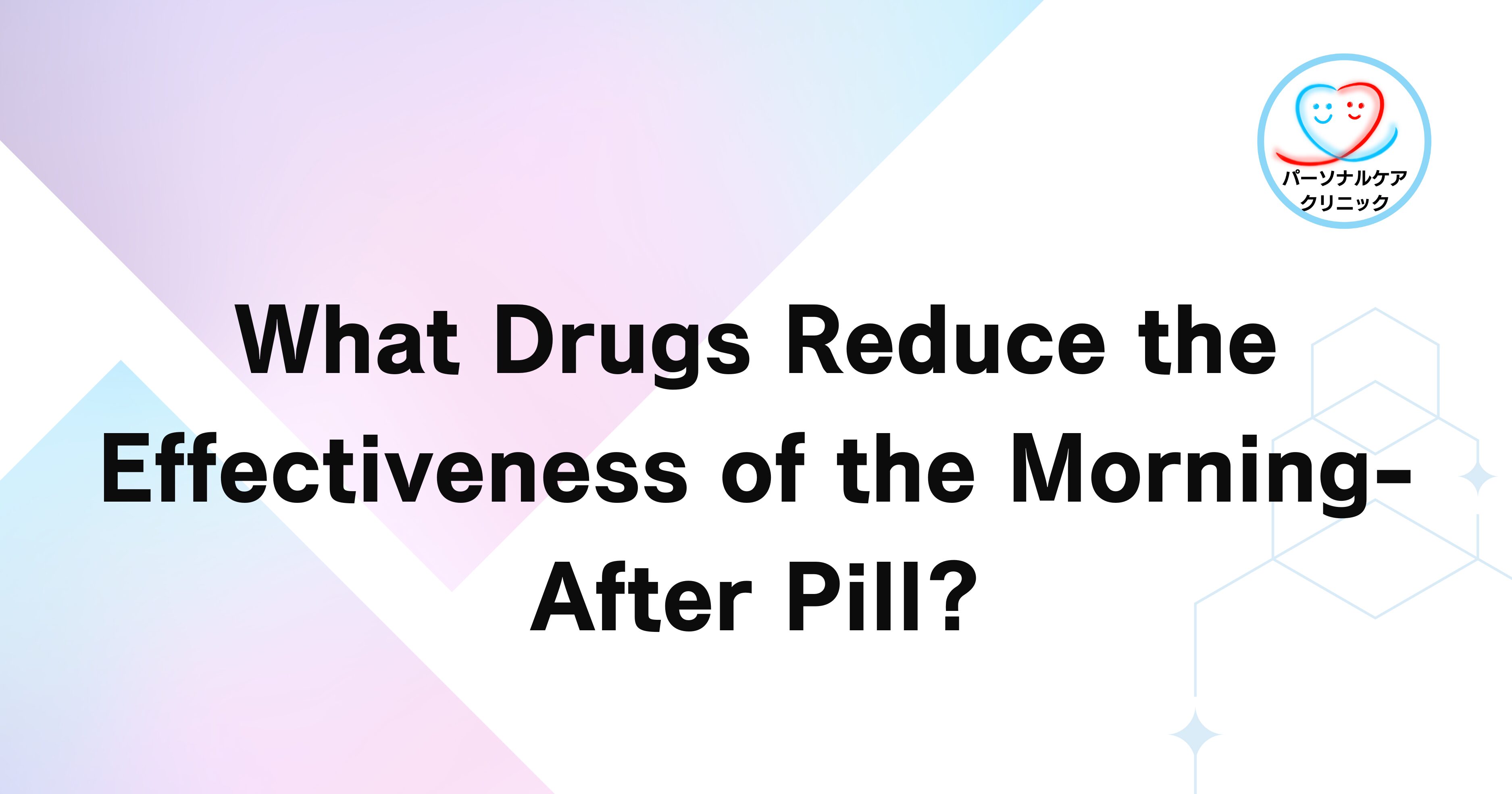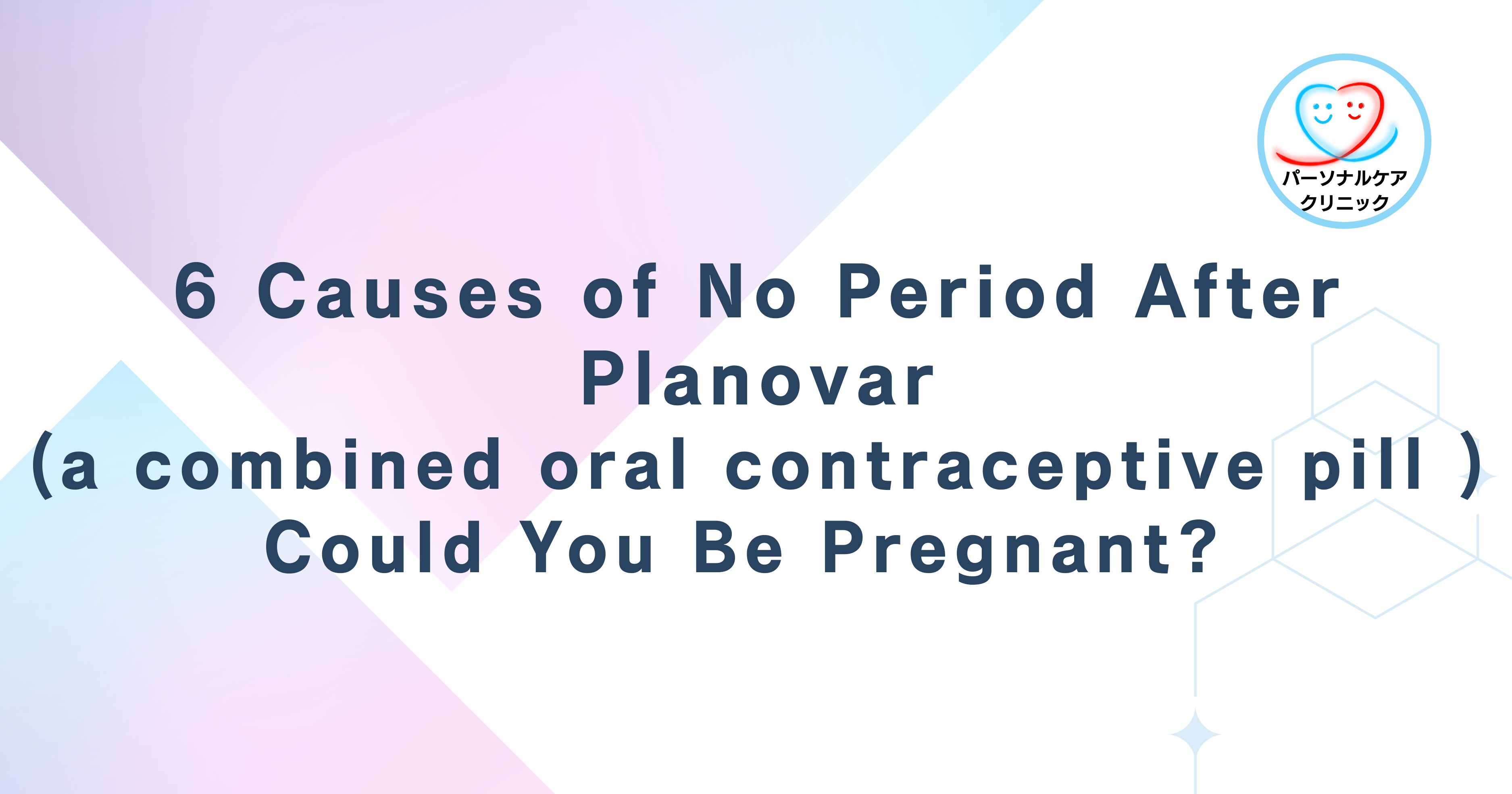“Withdrawal bleeding” that occurs after using an emergency contraceptive (the morning-after pill) and “implantation bleeding” that can appear in very early pregnancy often look and happen around similar times. Telling them apart is important when you want to confirm whether contraception worked. This article explains the differences and details the key points for judging if contraception succeeded after taking the morning-after pill. We also touch on spotting while using a low-dose pill and how to tell it from irregular bleeding, so readers can feel less worried about bleeding.

At Personal Care Clinic, the morning-after pill can be delivered in as little as 37 minutes.
The prescription process takes just 5 minutes, and if you apply before 10:30 AM, same-day pickup is available (depending on your area).
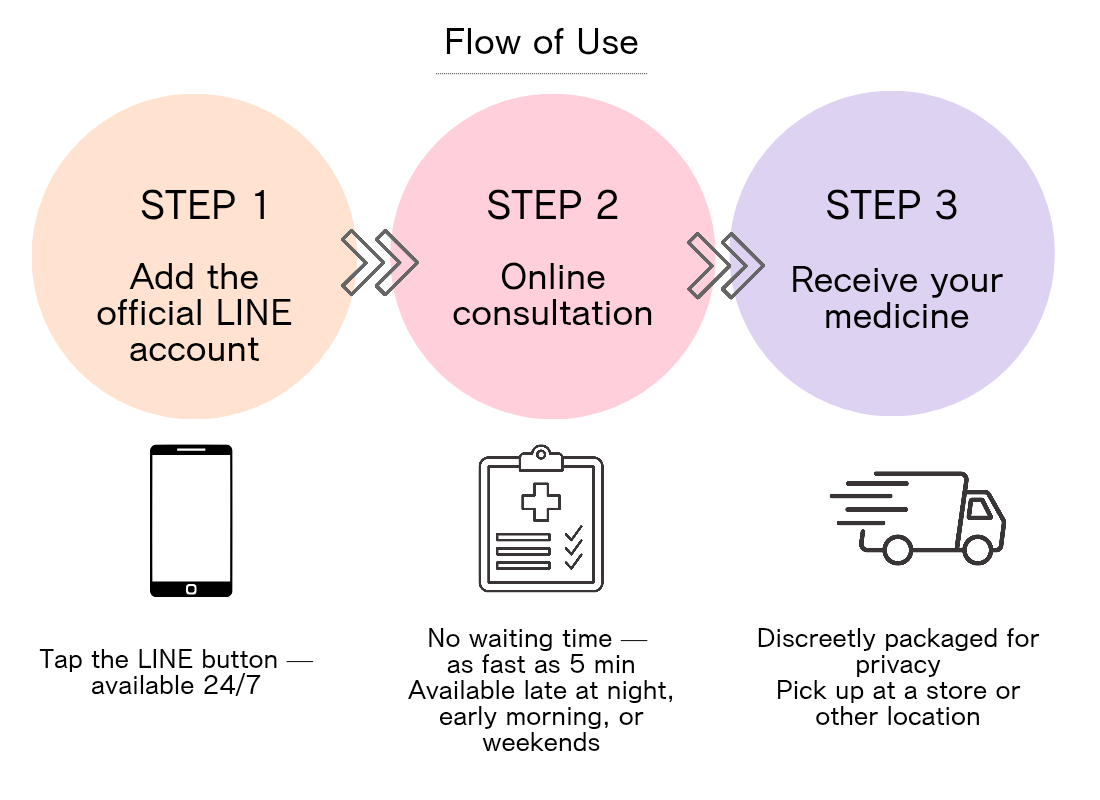
If you want to receive the morning-after pill discreetly, tap the button below to apply now.
Differences Between Withdrawal Bleeding and Implantation Bleeding

These two bleedings differ in their timing and appearance. Withdrawal bleeding follows use of the morning-after pill and happens because hormones cause the uterine lining to shed for a short time. In contrast, implantation bleeding is a light bleed that may occur when a fertilized egg attaches to the uterine lining—a very early sign of pregnancy.
What Is Withdrawal Bleeding?
Withdrawal bleeding is bleeding that occurs after you take the morning-after pill when the uterine lining sheds due to its hormonal effect. It usually appears within about one week of taking the pill. If this bleeding occurs, the pill may have worked. However, whether you bleed or not, you still need a pregnancy test a few weeks later to confirm the result.
Features of Withdrawal Bleeding
Withdrawal bleeding is typically a light, period-like bleed. Compared with a normal period, it is usually smaller in amount and shorter in duration. The color is often brown or dark red. Because it is triggered by hormonal changes after the pill, you may also notice period-like cramps. The timing is commonly a few days to about one week after taking the pill.
Is Withdrawal Bleeding the Same as a Period?
No—it is different from menstruation. A true period is the body’s natural shedding of the uterine lining after ovulation when pregnancy did not occur. Withdrawal bleeding is caused by the pill’s hormones forcing the lining to shed. Therefore, it is not the same as a normal period.
Read more about periods after the morning-after pill ≫
Is Withdrawal Bleeding the Same as Irregular Bleeding?
No. Withdrawal bleeding is an expected bleed after taking the pill. Irregular bleeding refers to bleeding of unclear cause. Among pill users, irregular bleeding can come from hormone shifts or missed pills. Withdrawal bleeding is temporary and usually normal, whereas irregular bleeding may need medical assessment.
Side effects of the morning-after pill ≫
What Is Implantation Bleeding?
Implantation bleeding is a light bleed that may occur when a fertilized egg implants in the uterine lining. This process is unrelated to the morning-after pill and is an early sign of pregnancy. It is usually very small in amount, pink or brown, and stops in about 1–2 days. Even if you are pregnant, implantation bleeding does not happen every time—it is more common not to have it. Do not use implantation bleeding alone to decide whether you are pregnant.
How to Tell Withdrawal Bleeding From Implantation Bleeding
There is no perfect at-home way to tell them apart. The most reliable method is a pregnancy test. As general guides: if you took the morning-after pill, withdrawal bleeding often appears within one week of dosing. Implantation bleeding, if it occurs, is around 7–10 days after ovulation and near your expected period date. Withdrawal bleeding can look somewhat like a light period; implantation bleeding is usually only a small amount.
How to Confirm Contraception Worked

After taking the morning-after pill, there are several key steps to check whether contraception succeeded: watch for withdrawal bleeding, use a pregnancy test, and see a doctor if needed. Below are the details so you can decide with confidence.
Whether Withdrawal Bleeding Occurs
Bleeding may occur within about one week after taking the pill. This happens when hormones make the uterine lining shed.
However, not everyone has withdrawal bleeding. If you do not bleed, do not panic. You still need a pregnancy test to make the final call.
Pregnancy Tests
A home pregnancy test is the surest way to confirm success. In general, if your period has not come by three weeks after taking the morning-after pill, use a test. Testing too early can mislead you, so wait the full three weeks. Using first-morning urine can improve accuracy. If you still feel unsure, test again one week later.
Doctor’s Assessment
If your test is negative but you remain worried, your withdrawal bleeding is irregular, or you have strong side effects, consider seeing a doctor. With ultrasound or blood tests, a clinician can check more accurately for pregnancy. If your period is late or you have unusual symptoms, seek advice early. Even if a home test is unclear, medical testing can give reassurance and options.
Can a Low-Dose Pill Also Cause Withdrawal Bleeding?

Yes, withdrawal bleeding can occur while using a low-dose combined pill. The pill prevents ovulation by providing steady daily hormones, but hormone shifts or missed pills can lead to withdrawal bleeding. In the first few months after starting, your body is still adjusting, so irregular bleeding is common.
With continued use, bleeding usually becomes lighter and more stable. Withdrawal bleeding does not mean the pill stopped working. Still, if bleeding persists or is heavy, consult a clinician.
Frequently Asked Questions About Withdrawal Bleeding

What amount and color should I expect?
It is usually small in amount. The color is often brown or dark red, but bright red can happen and varies by person. This bleeding is due to the pill’s hormones and is typically lighter than a normal period.
When does withdrawal bleeding start and how long does it last?
It often starts within one week after taking the morning-after pill and lasts a few days in most cases.
When will my next period come after withdrawal bleeding?
Your next period may take a few weeks to return to its usual timing as your cycle resets. If your period is late, always take a pregnancy test to confirm you are not pregnant.
3 Easy-to-Use Online Clinics

It is now easier to consult an online clinic for the morning-after pill or a low-dose pill. You can see a doctor while busy and get a prescription quickly. Below are three well-reviewed options. Compare their services and support to choose what fits you.
パーソナルケアクリニック (Personal Care Clinic)

(Source: Personal Care Clinic)
Personal Care Clinic is an online clinic focused on women’s health, offering quick prescriptions for the morning-after pill and low-dose pills. You can book easily on your phone, and online visits are available 24/7. It supports first-time users and regular users, protects privacy with anonymous home delivery, and offers video calls so you can speak directly with a doctor.
| Clinic | Personal Care Clinic |
|---|---|
| Counseling Fee | Free System usage fee: ¥1,093 |
| 72-Hour Morning-After Pill Fee | From ¥7,980 |
| 120-Hour Morning-After Pill Fee | From ¥12,525 |
| Shipping | Free *Special areas may incur extra charges |
| Delivery Date | Earliest: same day |
| Payment Methods | Credit card, convenience store payment, bank transfer after delivery, PayPay |
| Official Website | https://personalcareclinic.jp/ |
ソクピル (Soku Pill)
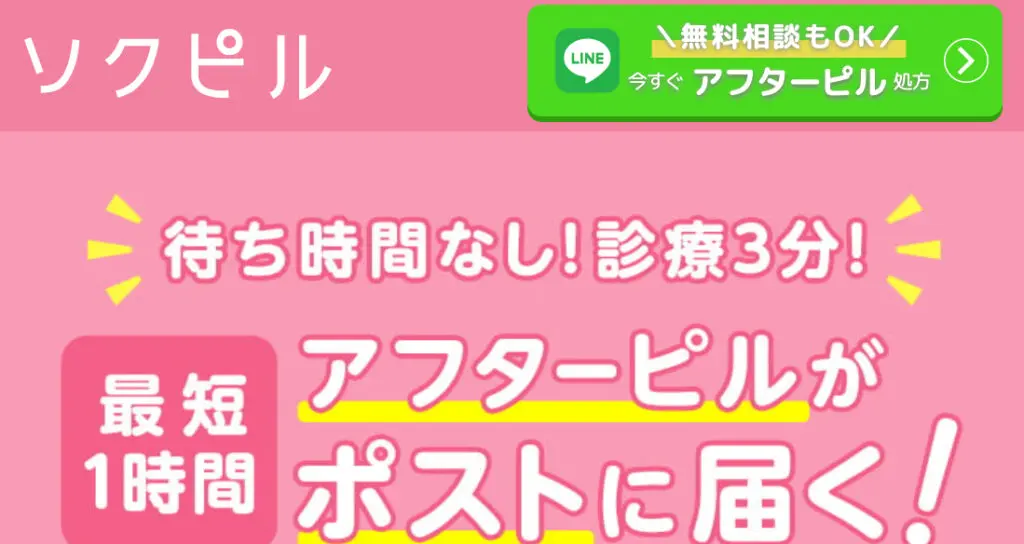
(Source: Soku Pill)
Soku Pill focuses on simplicity and speed. You can receive an emergency contraceptive or a low-dose pill as soon as the same day—reliable in urgent cases. A short questionnaire leads to a prescription decision. You can book online 24/7. Many users rate it highly for quick handling and reasonable prices. The simple flow and fast service are strong points.
| Clinic | Soku Pill |
|---|---|
| Counseling Fee | Free *Separate system usage fee: ¥3,630 |
| 72-Hour Morning-After Pill Fee | From ¥8,800 |
| 120-Hour Morning-After Pill Fee | From ¥16,500 |
| Shipping | ¥825 (Ex Express) *¥9,900 in some cases |
| Delivery Date | Earliest: same day (with Ex Express) |
| Payment Methods | Credit card, post-payment (convenience store), bank transfer |
| Official Website | https://soku-pill.com/ |
エニピル (Any Pill)

(Source: Any Pill)
Any Pill prescribes low-dose and emergency pills online with careful, tailored support for your health and lifestyle. It offers beginner-friendly guides and FAQs so you can proceed with less worry. The whole visit is completed online with minimal waiting. Anonymous delivery keeps your privacy protected. With fair pricing and solid support, it suits long-term users as well.
| Clinic | Any Pill |
|---|---|
| Counseling Fee | ¥2,200 |
| 72-Hour Morning-After Pill Fee | From ¥10,978 |
| 120-Hour Morning-After Pill Fee | From ¥10,978 |
| Shipping | ¥550 |
| Delivery Date | Earliest: next day |
| Payment Methods | Credit card, convenience store payment, post-payment, bank transfer |
| Official Website | https://any-pill.com/ |
Summary

Knowing the difference between withdrawal bleeding and implantation bleeding helps you check the effect of the morning-after pill and judge whether contraception worked. Withdrawal bleeding is an expected bleed within about one week after taking the pill and often means contraception likely succeeded. Implantation bleeding is a small, early-pregnancy bleed and can be hard to tell apart. A pregnancy test is essential for the final decision. If you have questions or worries about contraception, consult a clinician or specialist.
Related Articles





